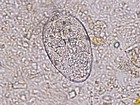Paramphistomum
Jump to navigation
Jump to search
| Paramphistomum | |
|---|---|
| Kingdom | Animalia |
| Phylum | Platyhelminthes |
| Class | Trematoda |
| Sub-class | Digenea |
| Order | Echinostomida |
| Family | Paramphistomatidae |
| Genus | Paramphistomum |
Introduction
Paramphistomum spp are of the family Paramphistomatidae. Paramphistomomes are rare in the UK, but can cause severe losses in ruminants in the wet tropics
The adult fluke is plump and cylindrical (unusual for a trematode). It attaches to the wall of the rumen without causing serious damage. The eggs are like those of Fasciola, but are colourless, and have long filaments present at the poles.
The intermediate hosts are water snails, and these shed cercariae which later form metacercariae on vegetation.
Disease occurs if metacercariae are eaten in large numbers. Enteritis and diarrhoea result when immature flukes migrate along the small intestine, (where the metacercariae excyst) towards the rumen.
Also see Trematodes - Overview.
| Paramphistomum Learning Resources | |
|---|---|
 Test your knowledge using flashcard type questions |
Trematodes Flashcards |
 Search for recent publications via CAB Abstract (CABI log in required) |
Paramphistomum publication |
| This article has been peer reviewed but is awaiting expert review. If you would like to help with this, please see more information about expert reviewing. |
Error in widget FBRecommend: unable to write file /var/www/wikivet.net/extensions/Widgets/compiled_templates/wrt665c68139c0299_80207634 Error in widget google+: unable to write file /var/www/wikivet.net/extensions/Widgets/compiled_templates/wrt665c68139f7aa0_76670063 Error in widget TwitterTweet: unable to write file /var/www/wikivet.net/extensions/Widgets/compiled_templates/wrt665c6813a2cf38_15924867
|
| WikiVet® Introduction - Help WikiVet - Report a Problem |
